Flour, eggs, milk, and butter come together with a kiss of sugar and vanilla in this cloud-like breakfast. You’ll be floating in bliss with the first bite of German Pancakes!
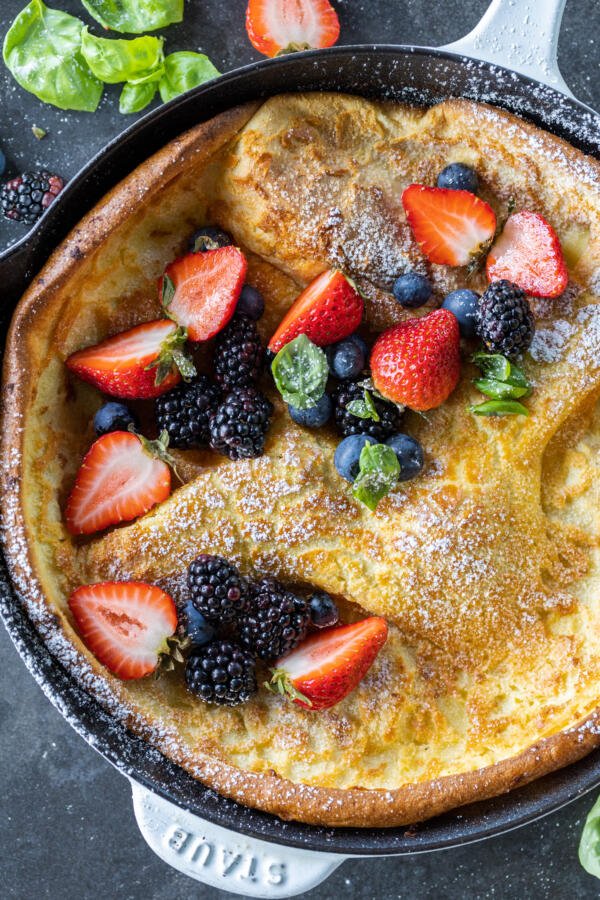
What are German Pancakes?
German pancakes, also called “Dutch baby” pancakes, are thick and fluffy cakes of batter baked in the oven. The batter contains more eggs than traditional American pancakes, and it omits chemical leavening agents (like baking powder or baking soda) typically used in pancakes. German pancakes are closely related to popovers or Yorkshire puddings, as they are served as either sweet or savory.
Contrary to the name, German pancakes are actually not German. The term “Dutch baby” was in fact coined in a cafe in Seattle, Washington in the early 1900’s to describe this new style of oven pancakes. However, the inspiration for this dish was likely derived from Pfannkuchen, the authentic German pancake.
How to Make German Pancakes
30 minutes, six ingredients, and an oven. That’s all it takes to whip up this easy and impressive breakfast.
- Preheat the oven and melt the butter: While the oven is preheating to 425°F, cut the butter into small pieces. Place them into a 10-inch baking dish or cast iron skillet in the oven to melt.
- Make the batter: Combine the remaining ingredients in a blender and blend until smooth.
- Bake: Pour the batter into the buttered pan and bake for 25 minutes.
- Serve: Remove the pan from the oven and enjoy with your favorite toppings.




Topping Ideas
The options to top German pancakes are never-ending, so here are a few creative ideas to get you started. This is where the fun begins!
- The classic: Dust the pancakes with powdered sugar and a drizzle of maple syrup for that nostalgic pancake flavor.
- Very berry: Top the pancakes generously with strawberries, blueberries, or any other fresh berries you like. Or, try a smothering of strawberry jam with a squeeze of fresh lemon juice for a bright kick.
- Chocolate lover’s: Indulge yourself with a layer of chocolate ganache on the pancakes. Add extra chocolate chips for a dessert dream.
Tips From the Kitchen
Follow these simple tips to ensure your German pancakes rise to the occasion (literally)!
- Bring your eggs and milk to room temperature. All the ingredients need to be at the same temperature in order for the batter to combine well and properly rise in the oven.
- Preheat your baking dish or cast iron skillet. A hot vessel is crucial for the trademark puff of German pancakes. As the batter hits the hot pan, the ingredients react together and rise.
- Keep the oven door closed while baking. Avoid the temptation to peek in, as cool air causes the pancake to deflate.
- Serve the pancakes hot and fresh. German pancakes are very sensitive to temperature, so serve them fresh out of the oven. The airiness of the eggs in the batter deflates over time.
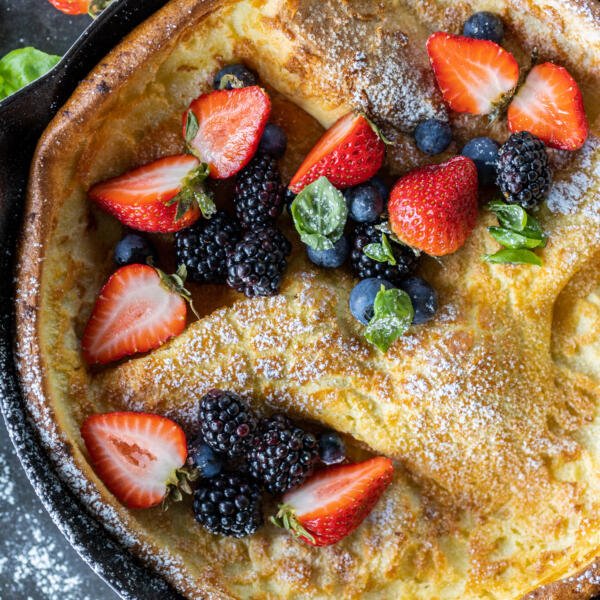
Ways to Serve
Add a Dutch baby to the breakfast or brunch table spread, and you are sure to please adults and kids alike. Make a mouthwatering hashbrown breakfast casserole to serve as a main dish alongside the pancakes. Or, serve them with the complementing eggy flavor of crustless quiche. Are you hosting and want to impress your guests? Assemble our breakfast charcuterie board and bring out the Dutch baby for a first-rate finale.
Storing and Reheating
German pancakes are best served immediately to preserve their airy and light texture. However, enjoy the leftovers as well by following these instructions for the best result.
- Refrigerating: For short-term storage, allow the pancake to cool completely, remove it from the skillet, then transfer to an airtight container in the refrigerator for 3-4 days.
- Freezing: Freeze German pancakes in a freezer bag for up to 2-3 months. Thaw in the fridge before reheating.
- Reheating: The best method for reheating is to place the pancake on a lined sheet tray and bake in the oven or toaster oven at 350°F for about five minutes. Microwaving is not recommended, as the pancake becomes soggy.
FAQ
What is the difference between German pancakes, Pfannkuchen, and Pannenkoeken?
German pancakes are uniquely oven pancakes, while Pfannkuchen and Pannenkoeken are traditional griddled pancakes. German pancakes are also the fluffiest compared to the thin Pfannkuchen and the crepe-like Pannenkoeken.
Why are they called German pancakes?
The origins of this name are quite mysterious, but it is speculated that German pancakes (also called Bismarck) were named by German immigrants in honor of Otto von Bismarck, the first Chancellor of the German empire. One way or another, the inventor of these pancakes surely derived some inspiration from the authentic German Pfannkuchen recipe.
Why didn’t my German pancakes rise?
Flat German pancakes could be due to two things: not enough aeration in the batter or not enough heat. This recipe calls for the use of a blender to whip air into the eggs, since there are no leavening agents. Pouring the batter into a pan that is not adequately preheated also leads to dense pancakes.
More Breakfast Recipes
- Oladi (Russian Pancakes) – Classic buttermilk pancakes with extra crispy edges
- The Perfect Crepes – These French delicacies are amazing on their own or filled
- Tater Tot Breakfast Casserole – A filling combination of sausage, eggs, cheese and tater tots
- Banana Waffles – Easy banana & buttermilk waffles
- Blueberry Pancakes – The irresistible classic, serve with warmed maple syrup
- Buttermilk Waffles – Fluffy, crispy, laden with pockets for maple syrup… you can’t go wrong with these waffles
- Banana Pancakes – Naturally sweetened, fluffy flapjacks
- Ricotta Pancakes – Tangy, moist and delicious!
Recipe
Ingredients
- 4 tbsp unsalted butter
- 3 large eggs room temperature
- 1/2 cup flour
- 1/2 cup whole milk room temperature
- 2 tbsp granulated sugar
- 1 tsp vanilla extract
Instructions
- Preheat the oven to 425°F. Cut butter into small pieces and place in a 10 inch round baking dish, or a cast iron skillet. Leave the butter in the oven to melt while it is preheating.
- In a blender, combine eggs, flour, milk, sugar, and vanilla extract. Blend until the mixture is smooth.
- Add batter to the pan with the melted butter. Bake for about 25 minutes or until the edges are golden brown.
- Once fully baked, remove from the oven and enjoy with your favorite toppings.

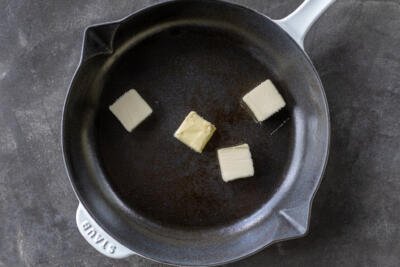
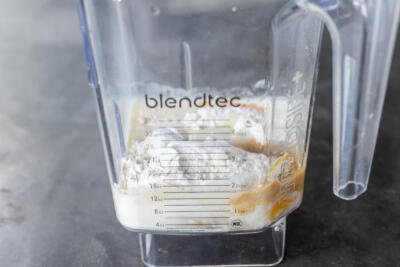
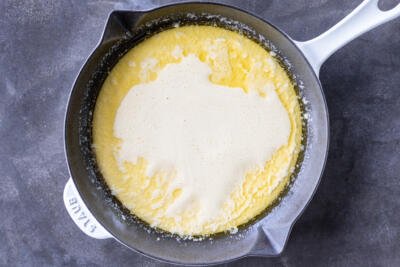
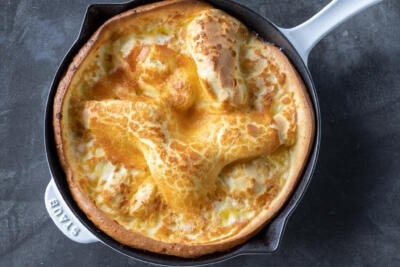
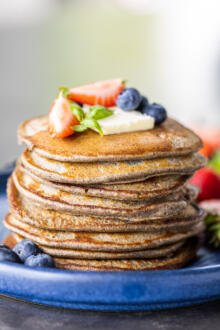





My go to every time!! Thanks 🙂
I'm thrilled that you found a go-to recipe you love! 😄 It's always exciting when you discover a dish that hits the spot every time. Thanks for sharing Mariana!